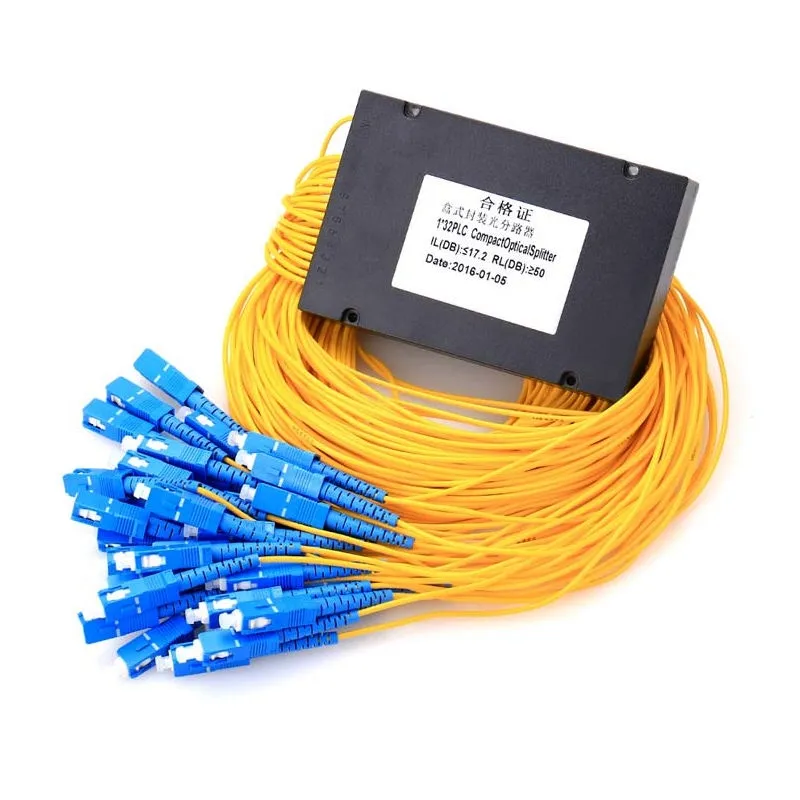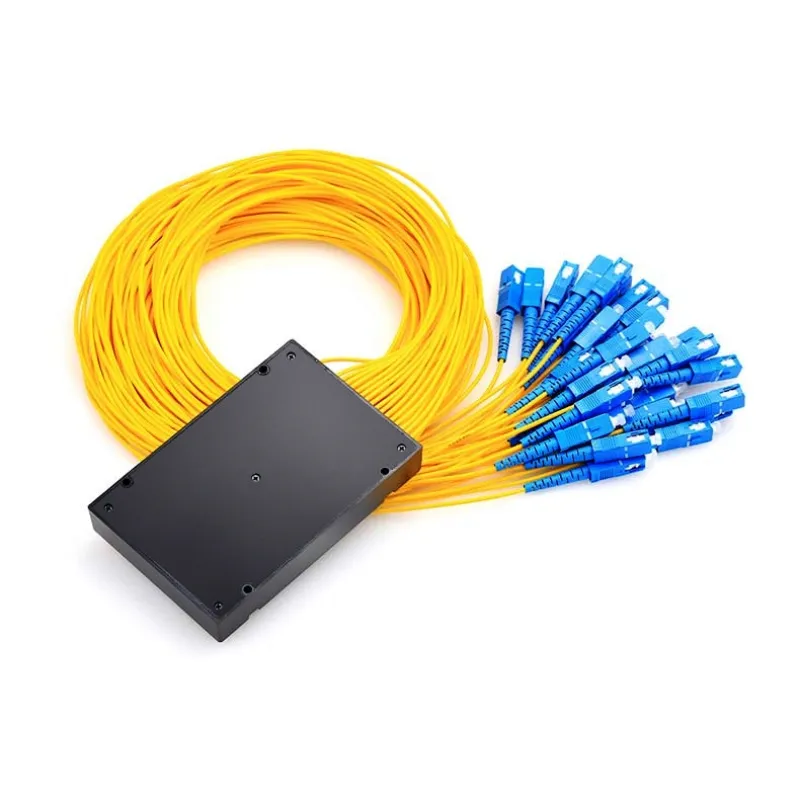What Is a PLC Splitter? Definition and Core Technology
Planar Lightwave Circuit Technology Explained
Planar Lightwave Circuits, or PLCs for short, represent one of the latest approaches to splitting optical signals through integrated optical components. At their core, these circuits rely heavily on advanced lithography methods that allow manufacturers to create complex waveguide structures right onto substrates. What makes these waveguides so valuable? They let engineers achieve remarkable precision while shrinking down optical parts significantly, which means better signal handling overall. Most PLC splitter designs today use either silicon or silica base materials because both offer excellent light transmission properties and last much longer than alternatives. The real advantage comes from how well these materials work across different wavelengths, typically covering everything between 1260 nanometers all the way up to 1650 nanometers. When talking shop in fiber optic circles, mentioning things like optical signal processing and integrated optics helps explain exactly what makes PLC splitters stand out among other technologies currently available in today's fast evolving telecom landscape.
Basic Function: Optical Signal Distribution
PLC splitters are really important components for splitting optical signals across several fiber optic cables without losing much quality. These devices basically have several input and output ports that let signals get spread out pretty evenly throughout the system. When light comes into one end of a PLC splitter, it gets split up so that all connected devices can receive their share at once. This works great for telecom companies and other fiber network operators who need to keep signals strong over long distances between cities or even countries. We see this technology everywhere from internet backbones to cable TV systems today. The way PLC splitters handle signal division makes them indispensable parts of modern communication infrastructure, helping maintain stable connections across vast networks while keeping costs down compared to alternative methods.
Working Principle of PLC Splitters
Optical Waveguide Structure
Optical waveguide structures form one of the most important parts of PLC splitters, allowing light to travel efficiently through these devices. Basically, what happens is the waveguide serves as the actual path for light signals moving through the splitter, keeping them intact throughout their journey. How these waveguides are designed matters a lot because they depend on something called optical confinement. This means the light stays inside the core material thanks to differences in how much the core and surrounding cladding bend light. When done right, this setup maintains good signal quality and cuts down on signal loss. Manufacturers pay close attention to controlling how the refractive index changes across different layers, which helps keep those light signals traveling straight without getting distorted too much during transmission. For anyone working with fiber optic networks, understanding this aspect makes all the difference in ensuring splitter reliability.
Signal Splitting Mechanism
How a PLC splitter actually splits signals comes down to how light interacts with those tiny waveguide structures inside. When light goes into the splitter, what happens next is pretty interesting stuff. The signal gets split up and sent along different paths at the same time. A few things affect this whole process. There's something called coupling loss where some light just disappears when moving from one fiber to another nearby fiber. Then there's power balance too, making sure each output channel gets roughly the same amount of power. Most people who work with these things know that PLC splitters tend to perform better than many other kinds on the market today. What makes them stand out? Well, they generally keep the power balanced across all outputs so everything stays consistent. That kind of reliability gives them an edge compared to alternative options available in the industry right now.
Key Advantages of PLC Splitters in Fiber Networks
Exceptional Signal Uniformity and Low Insertion Loss
Signal uniformity matters a lot for keeping fiber networks running at top quality, which is where PLC splitters really shine. These devices maintain steady signal strength throughout all output points, stopping those annoying fluctuations that can mess up network performance. Insertion loss basically means weaker signals as data travels through the system, but PLC splitter designs cut down on this problem significantly. The result? Better overall performance with clearer signals traveling farther without losing stability. When put next to older optical splitters, PLC versions just work better in practice. They keep signals from degrading so much and maintain that integrity we need for reliable connections. That's why most modern fiber installations are moving toward PLC technology these days.
Compact Size and Environmental Reliability
PLC splitters come in a small package which makes them great for those tricky installation spots where bigger splitters just won't work. The way they save space means technicians can put them exactly where needed without wasting precious real estate, especially important in crowded data center environments where every square inch counts. What really stands out about these devices though is how well they handle tough conditions. They don't mind extreme temperatures or damp environments at all, something that matters a lot when deployed in factories or outdoor settings. Industrial users love this because it means their systems keep running smoothly no matter what Mother Nature throws at them. And let's face it, nobody wants equipment failing simply because it got too hot or too cold during normal operations.
Critical Applications in Fiber Optic Networks
Passive Optical Networks (PON) and FTTX Systems
Passive Optical Networks, or PONs, form a key part of today's fiber optic communication infrastructure, especially when it comes to delivering fast internet connections. These networks rely heavily on something called PLC splitters, which work by splitting the optical signal across multiple fibers at once. This means service providers don't have to run separate cables everywhere, cutting down both time and money spent on installations. Take FTTX solutions for instance, whether we're talking about connecting homes directly (FTTH) or entire buildings (FTTB). In all these scenarios, PLC splitters help spread signals out reliably while keeping things scalable as demand grows. As fiber networks continue their worldwide rollout, the role of these tiny but powerful components becomes even more critical. Network operators who integrate PLC technology into their PON and FTTX setups find they can deliver better performance to customers, which matters a lot given how many people now stream videos, play online games, and work remotely from home.
Data Center Connectivity Solutions
Data centers rely heavily on PLC splitters to maintain strong high speed connections needed for all that data traffic flowing through them daily. When expanding facilities, operators need equipment that handles today's bandwidth requirements but also leaves room for growth down the road. These splitters check both boxes pretty well since they handle large volumes of data without much signal degradation or loss during transmission. What makes them stand out is how consistently they perform even when pushed hard by heavy workloads, which means data centers can build networks that grow alongside business needs rather than constantly tearing things apart for upgrades. The optical splitting tech behind these devices lets facilities keep running smoothly as internet usage keeps climbing and more services move to the cloud, giving companies better reliability and keeping them ahead of competitors in this fast moving digital world.

PLC Splitters vs FBT Splitters: Key Differences
Performance Comparison at High Split Ratios
Looking at how they perform, PLC splitters tend to outperform FBT (Fused Biconical Taper) splitters particularly when dealing with higher split ratios. What makes PLC splitters stand out? They keep signals pretty uniform across all outputs while keeping those pesky insertion losses minimal, even as the split ratio goes up. This matters a lot in situations where we need consistent transmission quality from multiple points. On the flip side, FBT splitters can be quite inconsistent. They often suffer from signal degradation and unequal distribution between outputs which really hurts overall system performance. The numbers back this up too research indicates that when working with high split ratios, PLC splitters have much lower insertion losses compared to their FBT counterparts. That's why many network designers are turning to PLC technology these days, especially for building out large scale systems where signal integrity remains absolutely critical.
Cost-Effectiveness Analysis
When looking at how much money PLC splitters save compared to FBT splitters, it becomes clear that while PLC models do cost more initially because manufacturers use sophisticated production methods, they actually end up costing less when considering maintenance and overall lifespan. The reason? These splitters maintain better signal quality as time goes on and don't need replacing nearly as often. Network engineers who install PLC splitters in their systems typically see financial advantages down the road. Even though there's more cash outlay at first, the total cost of owning a PLC splitter ends up being cheaper than FBT alternatives. This makes sense for anyone building networks where dependable operation matters more than cutting corners right away.
Selection Criteria for Optimal PLC Splitter Implementation
Splitting Ratio and Port Configuration
When designing a network, figuring out what splitting ratio works best matters quite a bit for both design quality and overall efficiency. The splitting ratio basically tells us how an optical signal gets split up among different output ports. Getting this right helps make sure we're making the most of available bandwidth while keeping signals distributed evenly across all connections. For networks that need to send lots of data to many endpoints at once, going with a higher splitting ratio often makes sense. Most systems come with standard port options such as 1x4, 1x8, or even 1x16 configurations depending on what kind of expansion needs exist. These different setups let network administrators scale their infrastructure when required without compromising speed or reliability. Network engineers who take time to really understand these ratios tend to build systems that perform better in real world conditions rather than just theoretical models.
Port configurations for PLC splitters come in all sorts of variations, so picking the right one really depends on what the application needs. Take densely packed city areas for instance they often need something robust like a 1x32 or even a 1x64 setup just to handle all those network connections properly. Visual diagrams help show exactly how these different splitter setups affect signal spread throughout the system, making it easier to pick the most suitable option for each situation. Getting this choice right matters because it meets today's network demands while still leaving room to grow when the time comes.
Packaging and Connector Compatibility
The way PLC splitters are packaged makes a big difference when it comes to installing and maintaining them down the road. There are several options out there including bare fiber, modules, and those LGX boxes we all know about. Each has its own strengths regarding how easy they are to handle and how well they protect the splitter during transport. Take modules for example these tend to work really well in factories since they can take some abuse. But if someone just needs something quick and simple for testing in a lab environment, going with bare fiber usually gets the job done without breaking the bank. Getting this right from the start means fewer headaches later on because the splitter stays in good condition and works properly over time rather than causing problems after installation.
When picking out a PLC splitter, connector compatibility matters just as much as other factors because it determines how well everything fits together in current systems. Most PLC splitters work with standard connectors like LC, SC, and MPO connectors that show up all over different kinds of networks these days. Getting the right match between splitter and what's already installed makes life easier during setup and avoids headaches later on. Technicians who know their way around those little ID codes and standards tend to pick better options that actually meet what the specs call for and follow what most folks in the field consider good practice. Matching up properly helps keep networks running smoothly without unexpected issues down the road.
The Essential Role of PLC Splitters in Network Efficiency
PLC splitters play a vital role in making networks work better, supporting both reliability and scalability in optical tech setups. These devices split light signals evenly among several outputs while keeping signal loss minimal, which explains why they're so important in modern network architecture. With their low insertion loss characteristics and even distribution capabilities, data moves through the system without hiccups or slowdowns, preventing those annoying traffic jams we all hate. Network administrators really appreciate this kind of dependability when dealing with demanding tasks such as large scale cloud operations or financial market data analysis where milliseconds count.
PLC splitters bring some pretty big benefits to the table when it comes to building networks that can handle whatever comes next. These devices let companies expand their network coverage while still keeping things running smoothly, which means businesses get way better scalability without having to sacrifice speed or reliability. Take data centers for instance they're seeing massive growth in traffic volumes right now, and PLC tech helps them keep up with those rising demands. Most experts agree that getting familiar with PLC splitter technology is becoming increasingly important for anyone managing modern infrastructure. When networks expand over time, these splitters help maintain good performance levels even as more devices connect to the system day after day.
FAQ Section
What is a PLC splitter used for?
PLC splitters are used for efficiently distributing optical signals across multiple fiber optic cables, particularly in telecommunication settings and optical fiber networks.
How does a PLC splitter work?
A PLC splitter divides an optical signal among multiple output paths using intricate waveguide structures, maintaining signal integrity through precise refractive index control.
What are the advantages of PLC splitters over FBT splitters?
PLC splitters maintain signal uniformity and low insertion loss at high split ratios, offering better performance and cost-effectiveness compared to FBT splitters.
How do I select the right PLC splitter for my network?
Select the correct splitting ratio and port configuration based on network demands, and ensure packaging type and connector compatibility match existing systems.
Table of Contents
- What Is a PLC Splitter? Definition and Core Technology
- Working Principle of PLC Splitters
- Key Advantages of PLC Splitters in Fiber Networks
- Critical Applications in Fiber Optic Networks
- PLC Splitters vs FBT Splitters: Key Differences
- Selection Criteria for Optimal PLC Splitter Implementation
- The Essential Role of PLC Splitters in Network Efficiency
- FAQ Section

